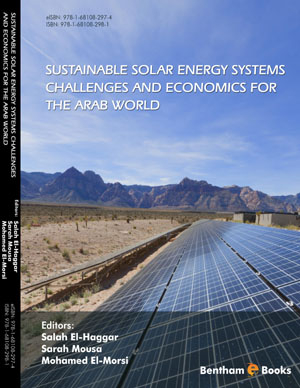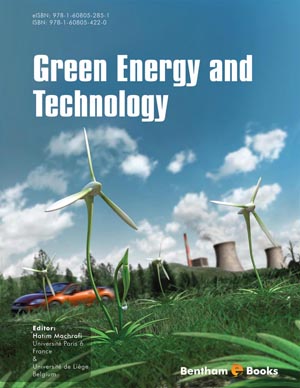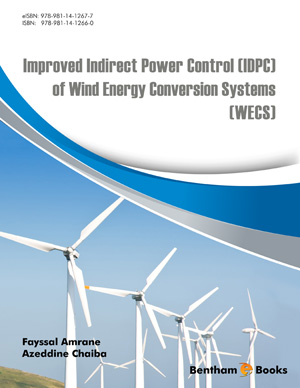Preface
Page: iii-iii (1)
Author: Salah El-Haggar, Sarah Mousa and Mohamed El-Morsi
DOI: 10.2174/9781681082974116010002
Acknowledgements
Page: iv-iv (1)
Author: Salah El-Haggar, Sarah Mousa and Mohamed El-Morsi
DOI: 10.2174/9781681082974116010003
List of Contributors
Page: v-v (1)
Author: Salah El-Haggar, Sarah Mousa and Mohamed El-Morsi
DOI: 10.2174/9781681082974116010004
About the Authors
Page: vi-vii (2)
Author: Salah El-Haggar, Sarah Mousa and Mohamed El-Morsi
DOI: 10.2174/9781681082974116010005
Introduction
Page: viii-ix (2)
Author: Salah El-Haggar, Sarah Mousa and Mohamed El-Morsi
DOI: 10.2174/9781681082974116010006
Sunlight and Solar Radiation
Page: 3-9 (7)
Author: Sarah Mousa, Mohamed El-Morsi and Salah El-Haggar
DOI: 10.2174/9781681082974116010007
PDF Price: $15
Abstract
The sun is a hot sphere of gas with an internal temperature of 15 million degrees Celsius, the surface of the sun is at a temperature that is approximately 5500 Kelvin. The total power emitted by the sun is 3.83×1026 W, and the intensity is about 6.33×107 W/m2. The solar radiation reaching the earth’s surface, 1367 W/m 2 , is reduced by absorption, reflection and scattering of the atmosphere. Solar radiation and its intensity on earth’s surface varies based on latitude and longitude location, time of year, time of day, local atmospheric variations such as vapor, cloud or pollution concentration, and atmospheric effects such as absorption and scattering. All these are crucial factors when considering the optimum design and location for solar powered technologies. This chapter will help us consider where, when and how solar radiation should be harnessed in order to take the greatest advantage of energy reaching the earth’s surface.
Climate Change
Page: 10-16 (7)
Author: Sarah Mousa, Mohamed El-Morsi and Salah El-Haggar
DOI: 10.2174/9781681082974116010008
PDF Price: $15
Abstract
The earth’s temperature is determined by the incoming radiation from the sun and the outgoing infrared radiation emitted by the earth. Radiation emitted by the earth is largely dependent on the composition of the earth’s atmosphere. The accumulation of greenhouse gases, due to human activities, in the earth’s atmosphere absorbs infrared radiation emitted by the earth’s surface and keeps it in the atmosphere. With today’s rate of fossil fuel utility, compounds are released into the atmosphere, soil and seas on a daily basis, resulting in significant changes in the atmosphere. In recognition of how damage caused by fossil fuels harms an environment shared by all, the United Nations Framework Convention on Climate Change (UNFCC) put forth the Kyoto Protocol in 1997. Climate change is among the many reasons, which make increased research on and immediate implementation of solar powered technologies not simply a luxury, but a necessity for the future environmental wellbeing of earth. This chapter presents the problem of global warming, its reasons and efforts led by decision makers to seek various approaches to tackle the core of the problem and mitigate its severe environmental, economic and social impacts.
Solar Energy and Associated Benefits
Page: 17-25 (9)
Author: Sarah Mousa, Mohamed El-Morsi and Salah El-Haggar
DOI: 10.2174/9781681082974116010009
PDF Price: $15
Abstract
The environmental problems associated with the use of fossil fuels can be largely diminished by changing to renewable energy sources. Traditional energy sources are harmful to the environment on both local and global scales, largely because their use is associated with the emission of greenhouse gases. Solar power systems, along with those which rely on other renewable energy sources such as wind and hydroelectric power, produce minimal carbon emissions. Considering its abundance, solar energy presents itself as a clean viable main energy source alternative to traditional reliance on fossil fuels. On the economic level, solar energy has the potential to serve as a stimulant for economic growth and sustainable development. Throughout the world, and particularly in developing countries, access to energy is highly correlated with social and economic factors. Access to affordable energy for all is crucial for economic growth. Also, the social benefits associated with the usage of solar energy are potentially most significant for underserved populations in developing countries. This chapter shows how solar energy presents itself as an alternative to traditional energy sources that is healthier for both the environment and humanity, and has the potential to enhance the social and economic fabric of a community.
Solar Powered Technologies
Page: 26-58 (33)
Author: Sarah Mousa, Mohamed El-Morsi and Salah El-Haggar
DOI: 10.2174/9781681082974116010010
PDF Price: $15
Abstract
Solar energy is a viable alternative to traditional energy sources it is healthier for both the environment and humanity, and has the potential to enhance the social and economic fabric of a community. In this chapter the basic mechanisms of several solar powered technologies are addressed. These technologies include passive building design, solar dryers, solar cookers, solar water desalination, solar water heating, solar electricity, and solar fuels.
Solar Power and Sustainable Development
Page: 59-84 (26)
Author: Sarah Mousa, Mohamed El-Morsi and Salah El-Haggar
DOI: 10.2174/9781681082974116010011
PDF Price: $15
Abstract
The need to account for sustainable development when it comes to energy is crucial; the major energy sources in current use are unsustainable in that they harm the environment and deplete resources for current generations and especially for future ones. Significant amounts of energy can be saved if a technology used to accomplish a given task is designed efficiently. Examples include the use of (i) passive building design to meet the heating and cooling demands of buildings, and (ii) solar energy for water heating, generating electricity, water desalination and cooking. Several case studies, presented in this chapter, from different geographic locations show that several technologies can be adopted to meet a certain energy use without scarifying the environmental, social, cultural, and/or aesthetic standards.
Natural Lighting in Buildings
Page: 85-102 (18)
Author: Khaled Nassar
DOI: 10.2174/9781681082974116010012
PDF Price: $15
Abstract
Natural lighting is an essential element in successful design in order to decrease the electrical lighting energy consumption while ensuring visual comfort such as the reduction of glare. This chapter presents the topic of daylighting as it pertains to the urban scale. The chapter first provides an overview of the several benefits of daylighting in various applications. Some fundamentals about daylighting are then presented. This is followed by the presentation of the concept of solar envelopes as an important aspect of daylighting in the urban scale. Then different studies pertaining to daylighting at the urban scale are presented.
Challenges in The Arab World
Page: 103-110 (8)
Author: Sarah Mousa, Mohamed El-Morsi and Salah El-Haggar
DOI: 10.2174/9781681082974116010013
PDF Price: $15
Abstract
The MENA region receives between 22% and 26% of all solar energy striking the earth. This translates to a potential for solar energy per square kilometer per year equivalent to the energy generated from 1 to 2 million barrels of oil. Despite this, the region continues to deplete limited resources and escalate tensions over competition for the use of these resources. The MENA region only holds 1.8% of the world installed capacity of solar water heaters and 0.68% of the installed PV worldwide capacity. Governments of the Arab world often don’t regard environmental protection and associated methods, renewable energy, as an economically or developmentally important. As a result the effort is often unfocused and driven simply by modest concern for international treaties. This chapter presents some of the challenges facing the implementation of solar powered technologies in the Arab world. These challenges are related to both the technologies themselves and the political and social factors.
Feasibility of Solar Energy
Page: 111-183 (73)
Author: Ghada Abdel Aziem, Khaled Nassar and Salah El-Haggar
DOI: 10.2174/9781681082974116010014
PDF Price: $15
Abstract
A model is developed to study the economic feasibility of adopting two kinds of solar technologies namely; solar water heaters and photovoltaics to substitute traditional systems in the residential sector. The model is a decision support system tool that guides investors and decision makers on the optimal scheme to utilize their funds and maximize the return on investment using an optimization approach over a duration of 10 years. The model considers offering a subsidy to support the diffusion of the systems through an initial fund of $1,500,000 in terms of a line of credit. The model computes the net present worth of the project and the line of credit payback period. In addition, the model provides annual percentages of the amount of money to be used in the reinvestment versus the amount used to pay back the line of credit. A case study is conducted and three proposed scenarios are applied namely; lease, loan and power-cuts tariff. The results of the study shows that the SWH line of credit payback period for the Lease, Loan and Power-Cut Tariff are 10, 9, and 10 years while the PV line of credit payback period for the Lease, Loan and Power-Cut Tariff are 8, 5, and 5 years.
Heating Poultry Houses Using Renewable Energy
Page: 184-231 (48)
Author: Heidi El Zanaty, Mohamed El-Morsi and Salah El-Haggar
DOI: 10.2174/9781681082974116010015
PDF Price: $15
Abstract
In broilers poultry house, fuel-based heating systems are commonly used to maintain the targeted temperatures for successful breeding of chicken. A considerable amount of fuel is consumed for this application, which leads to high running cost and contributes to the increase of air pollutant emissions. To investigate the economic feasibility of using solar energy as a substitute for the heating of poultry houses, a case study is conducted on a poultry broiler house located in El-Menia in Egypt. The location is selected based on the controversy foreseen due to the availability of high solar radiations versus the low fuel prices and absence of tax credits in Egypt. The case study includes the technical and economic study for a solar heating system (SHS) and the integration of biogas produced from chicken manure as an auxiliary source of heat. The heating demand is calculated hourly over a complete year using TRNSYS simulation tool. Accordingly, a SHS is designed to cover part of this demand besides a fuel based auxiliary source. The two main design variables of the SHS are the area of the solar collector and the volume of the storage tanks. An economical study of the SHS is carried out, where the net present value is calculated. The calculation is performed using the Egyptian and international fuel price.
Subject Index
Page: 232-234 (3)
Author: Salah El-Haggar, Sarah Mousa and Mohamed El-Morsi
DOI: 10.2174/9781681082974116010016
Introduction
The urgency of exploring alternative energy sources, especially in regions so detrimentally affected by current energy practices on environmental, humanitarian and political levels warrants a crucial effort in raising awareness and activism about renewable energy and sustainable development. Sustainable Solar Energy Systems is a primer on the application of solar energy technology for sustainable development. This handbook starts with an introduction to basic concepts of solar energy, describes the mechanisms and benefits of related technologies, and presents a case study in an Arabian poultry farm. The book also includes details on how to conduct economic feasibility studies of solar power projects. The book is a suitable reference for general readers or students undertaking environmental science or engineering courses with specific modules on solar energy projects. Readers will be able to understand the benefits of solar energy systems in the context of an increasing concern about the use of renewable energy under conditions of global warming and declining fossil fuel reserves.













